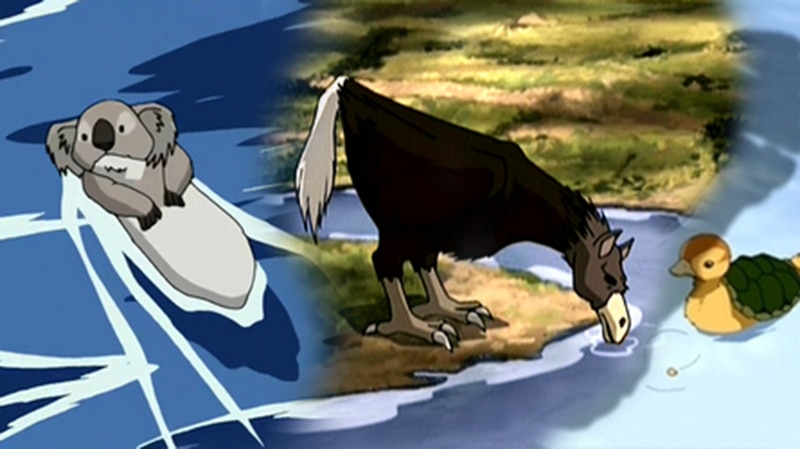Create a free profile to get unlimited access to exclusive videos, sweepstakes, and more!
Could any of Avatar: The Last Airbender's hybrid animals actually exist?

Avatar: The Last Airbender came to Netflix last month, and tons of people are watching the acclaimed cartoon — either revisiting its epic tale or experiencing the saga for the first time. It's widely considered one of the best animated shows ever made, and it's filled with all manner of adorable, and magical, hybrid animals. Plenty of people might daydream of being able to bend the elements to their will. I dream of living in a world filled with koalaotters, turtle seals, and ostrich horses.
Sadly, we live in a world filled with ordinary, boring, non-hybrid life. Or do we?
THE FIRST HYBRID
A billion years after the Earth was formed, the first prokaryotes appeared. Prokaryotes include some of the simplest forms of life on Earth. While they are cellular, they neither have an enclosed nucleus or specialized, membrane-bound organelles. Instead, their DNA floats around the cell's interior cytoplasm.
While prokaryotes were likely the first living things to arise on Earth, they aren't doing too bad for themselves, even today. Despite the many varied branches of evolution, many prokaryotes, like bacteria, are perfectly happy staying more-or-less as they've always been.
In order for all of those evolutionary branches to happen, however, a significant shift needed to occur. Multicellular organisms require a different type of cell structure entirely. Namely, eukaryotic cells. Eukaryotes differ from prokaryotes in a number of significant ways, but most importantly, they have a nucleus enclosing their DNA, and they have membrane-bound organelles.
It's those organelles that give us a hint as to how this important step in cellular evolution occurred and give us a window toward, perhaps, the world's earliest hybrid organism.
The endosymbiotic theory is one widely accepted explanation for how eukaryotes became so complex. It goes like this: Some prokaryotes were larger than others and would have consumed their smaller counterparts in a process known as endocytosis. When this occurs, the consumed organism is digested and that's the end of that.
Endosymbiosis occurs through the same process, but with distinctly different results. In this scenario, the smaller prokaryote is consumed but is not digested. Instead, it lives inside the larger organism as one part of a mutually beneficial partnership. This likely happened when an anaerobic organism consumed an aerobic one. A similar situation might have occurred with the consumption of an organism capable of photosynthesis.
In such a scenario, the larger organism would have protected the smaller by providing it with an extra layer of protection from the outside world, while the now-bound organism would have provided the ability to process sunlight or oxygen for energy production.
There is good evidence that this actually happened. Organelles like mitochondria and chloroplast are approximately the size of bacteria and, more importantly, contain their own DNA separate from that of the larger cell. Additionally, they divide in much the same way as bacteria. In short, eukaryotic cells behave precisely how we would expect them to if they were actually several less complicated cells working in concert.
We have every reason to believe that eukaryotes are hybrid organisms and that hybridization is the only thing that made complex life on Earth, possible.
MODERN HYBRIDS
As we move along life's complexity scale, hybridization becomes increasingly complex. Plants hybridize pretty frequently, owing to their pollen spreading over large areas. This can happen naturally, or as a deliberate result of human intervention.
For instance, corn bred from the same stock over long periods of time experiences what's known as inbreeding depression. Intentionally hybridizing these depressed lines can result in increased yields. This practice is used in more than 90 percent of all corn grown.
Plants seem to like hybridization and take to it without too much fuss. Animals, however, are another story. Even among genetically similar animals, hybridization is fickle. Humans, chimpanzees, and bonobos share almost 99 percent of the same DNA, yet cannot interbreed (probably for the best).
That isn't to say that interbreeding between disparate species doesn't happen. There is evidence of interbreeding between humans, Neanderthals, and other hominids in our recent past. And, interbreeding between nearly related species still happens today.
Lions and tigers can mate, creating ligers and tigons. The name of the hybrid depends on which of the two disparate species is the mother and which is the father, with the naming convention taking its first part from the male.
Mules are well-known farm animals resulting from the mating of a horse and a donkey. Zebras and horses, having split about two million years ago, are able to produce stunningly beautiful, yet sterile, offspring. Buffalo and cows, narwhals and belugas — the list goes on.
Most of these animals are bred intentionally, for show. The ethics of such a practice are questionable at best.
One example of animal hybridization, though, happens naturally and may be a response to shifting climates. Grolar Bears. Grizzlies and polar bears diverged only about 150,000 years ago, making them much more genetically similar. It's ironic then, that new changes in the climate, primarily caused by humans, is now pushing those disparate groups back together.
Not only are polar bears and grizzly bears capable of interbreeding, but their offspring also remain fertile as well. This opens the possibility that as the climate continues to shift, these two disparate species could become one.
There's a similar story happening with some Cuban crocodilians, suggesting that hybridization between close evolutionary relatives might be a normal and necessary part of natural selection.
ARTIFICIAL HYBRIDS
Now we get to the truly weird stuff. Nature can only go so far, limited by what is possible in everyday biology. But given the ability to sequence and manipulate DNA, our scientists are pushing the boundaries of what can be done in a lab.
In 2015, scientists modified chicken embryos to make their faces more closely resemble dinosaurs. The embryos were not hatched but the researchers believe they would have survived.
In case modifying non-human animals isn't bizarre enough for you, scientists have succeeded in creating the first human-animal hybrids.
Human cells were implanted into pig embryos and later implanted into female pigs. These embryos were carried successfully for several weeks before being removed. Pigs share genetic and structural similarities to humans and the ultimate goal is to create animals that would be capable of growing organs suitable for human transplantation.
While these experiments were successful, we're still a far cry from being able to put the process into practice.
Still, for a little while, human-pig hybrids existed.
George Orwell, eat your heart out.














